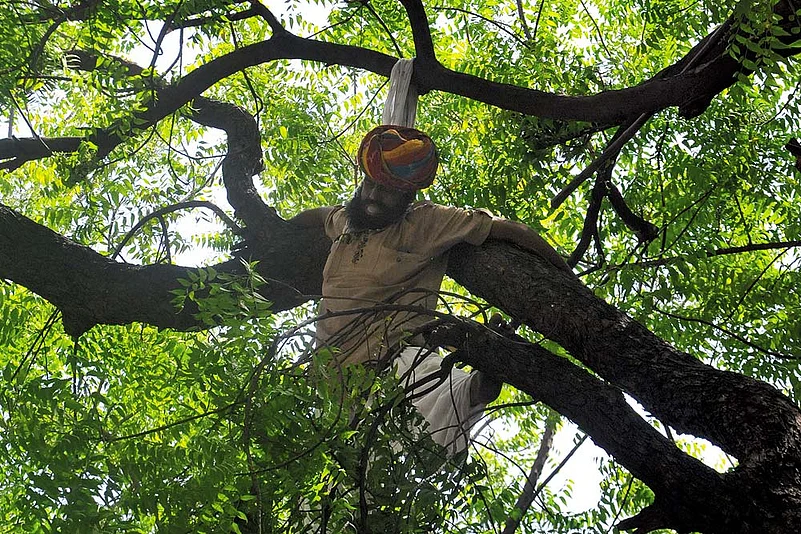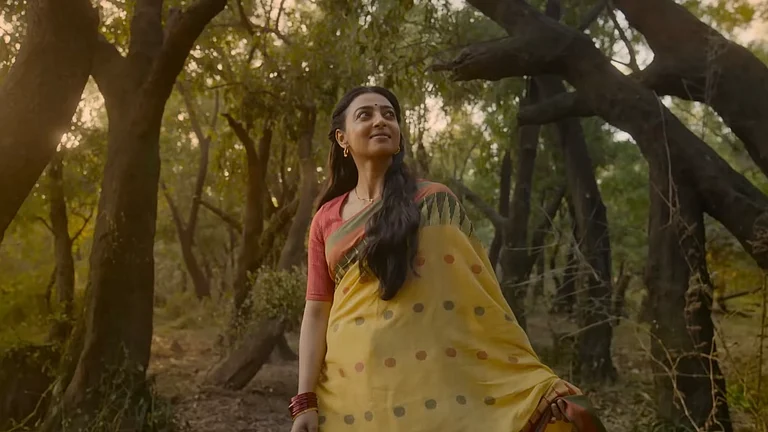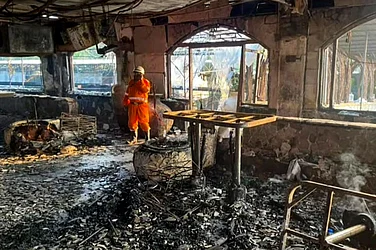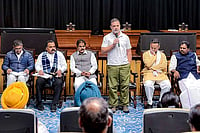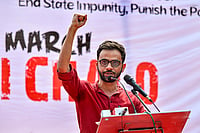A man’s body swung from a tree in the national capital last week. It was disturbing, it was tragic, it was for real. Some newspaper reports have speculated on whether the man actually intended to kill himself. But in the end, he was dead. Gajendra Singh’s final moments were spent at a rally called by the Aam Admi Party (AAP) and Delhi chief minister Arvind Kejriwal. In its reaction to the suicide, AAP bungled. Kejriwal had continued with his speech, not realising the man was dead. The party’s spokespersons struck the wrong note by sounding sarcastic, offended and angry when they should have sounded contrite, sad and regretful. BJP spokespersons suggest that somehow this was a stunt instigated by AAP and the Delhi police (under the Centre) is investigating AAP’ ‘abetment’ of the suicide.
But the greater damage—for all the discomfort and the questions being raised about the sequence of events at the AAP rally—has been done to the BJP and Prime Minister Narendra Modi. A farmer had died, and he would not be an invisible statistic from Vidarbha (the place most associated with farmer suicides). He had died at Jantar Mantar, the protest spot of Delhi, a short walk from Parliament, which is in session, and where the ruling party has been trying to get a consensus on getting changes to land acquisition laws passed in Rajya Sabha. Every action of Gajendra Singh’s was therefore recorded on television and still cameras. In a strange way, this gave the tragedy a touch of farce.
There was apparently a suicide note, in which Gajendra Singh said he was a farmer from Dausa, Rajasthan, whose crops had been damaged by unseasonal rain. Before he died from the choke-hold of his gamcha, Gajendra Singh had raised slogans of ‘Vasundhara-Modi, kisan virodhi!’ As the Modi government approaches its first anniversary, the prime minister is being encircled. The greatest performances, it seems, now happen abroad. In Apna Desh, it’s tough going. This dichotomy is now quite visible, to even his supporters. Last week, in BJP circles, an SMS was in circulation: “We are pleased to announce the fifth visit in the last 10 months of Prime Minister Narendra Modi to the Republic of India. The MEA believes this shows the strategic importance of India.” The fact that people who were in raptures over Modi just months ago now resort to sarcastic jokes about his reign underlines the beginning of anti-incumbency, also visible in the Delhi elections in February this year.

New parivar The Janata group is a new headache for Modi. (Photograph by Tribhuvan Tiwari)
What has happened is this: the prime minister has put his prestige on stake with an insistence on changing the land acquisition law, and that is turning into a political and public relations disaster for his party. It does appear that land could be Modi’s ‘India Shining’ disaster, for it has become a narrative of haves versus have-nots. The opposition has suddenly grown green shoots. Ranged against Modi is an apparently reborn Rahul Gandhi who is having a very energetic phase after a period of depression. He’s made it about the ‘suits’ versus the ‘people’, as he fights his own battles to try and become Congress president. Rejuvenated too is Sitaram Yechury, newly elected general secretary of the CPI(M), who has always pulled heavier punches in Parliament than the numbers that his party actually has. Energised too is the newly united Janata parivar, which will be ranged against the Modi-Amit Shah-led BJP in Bihar, in state elections in October this year. When the next contest is in one of the poorest states of the country, it’s naturally against good sense to pursue a policy that invites the “anti-poor” rhetoric.
Modi must have realised by now that the hype of the 2014 campaign cannot be turned into a reality in the manner in which he had perhaps believed and/or made it sound possible. The hellish realities of India have come into play and, as it turns out, Bharat is not Gujarat, that is, one of the most urbanised states in the country, where a particular development model could be made to work. One year down the line, business growth has not lived up to the hype, the middle class is not growing, and the stockmarkets have lost the zing of hope. And land, it seems, has been manna from heaven for the Opposition, and suddenly it seems there is life after defeat. Most non-NDA parties are united on the emotive issue of ‘do bigha zameen’ and the Opposition has certainly ‘landed’ on its feet. The backdrop to the political theatre is a mounting agricultural crisis in parts of the country. Unseasonal rain has destroyed crops at a time when the NDA’s economic philosophy involves cutting back on social sector spending. The number of farmer suicides is expected to only go up from what was already a regular phenomenon during the UPA and NDA-I years. The day Gajendra Singh died, the Met office predicted the second successive year of deficient rains. The climate for Modi has both literally and metaphorically changed. Whether or not the BJP’s arguments for amending the land laws make for sensible economics or merciless policies is not the point. What has happened is that Modi has lost the battle of perceptions on the land issue. It has boxed him into a political position that is seen to be anti-poor and pro-corporate. This is usually a disaster for politicians. Down the decades, slogans that have worked have been those such as ‘Garibi Hatao’ (Remove Poverty) used by Indira Gandhi in 1971 to win a landslide after she broke off from the old guard and took a sharp left turn in her positioning (There’s an interesting parallel with what Rahul seems to want to do). Before that was the ‘Jai Jawan, Jai Kisan’ (Hail the soldier/ Hail the farmer) slogan raised by Prime Minister Lal Bahadur Shastri in 1965, after the war with Pakistan. There have been other slogans that played up individual politicians, such as ‘Agli Baari, Atal Behari (Now it’s Atal Behari’s turn)’ in 1996 just as the 2014 ‘Abki Baar Modi Sarkar (This time a Modi government)’ is a variation on the former. After Indira Gandhi’s assassination in 1984 came the slogan ‘Jab tak sooraj chand rahega/ Indira tera naam rahega (As long as there is the sun and the moon/ Indira your name shall be remembered)’. But what the BJP could not have forgotten is the 2004 ‘India Shining’ slogan that backfired so badly on the regime and gave the Congress a surprise win. The slogan to counter ‘India Shining’ was ‘Congress ka haath/ Aam admi ke saath (The Congress hand is with the common man)’.
***
Landing Trouble
What Modi can do to extricate himself from the field of landmines he is in
- Keep At It
Pass ordinances to show he means business, but then the issue would remain alive politically, especially with Bihar poll around the corner. Then again, will the President go along happily?
- Woo The Flock
Work on amenable regional parties who hold the key to getting amendments passed in the Upper House. Assiduously pursue Mayawati, Jayalalitha, Naveen Patnaik.
- Back Off Now
Would be an admission that he got his sums wrong and be a blow to his prestige. Failure of the “shock doctrine”—ramming it home—will also hamper future efforts to revive it.
- Call A Joint Session
Bell the Opposition cat to show where parties stand on industrialisation and job creation. But so early in his reign, would be a big risk and bad form to sidestep existing parliamentary norms.
- Communicate
Use every media strategy available to him and his partymen to take the message across that the land bill is in the interests of the people and hope that they will be able to put pressure on MPs
***
Now, barely one year into his reign, Modi appears to have created an image problem for himself. From packaging himself as the chaiwala who smashed the culture of privilege, he’s now being seen as the facilitator of big business. As a talented mass politician, at the very least, he should be confronted by an existential crisis. In trying to make it more “feasible” for investors and industry to acquire land, he is actually only trying to live up to the dream he sold: smart cities, lots of industry, ‘Make in India’, Grow, Develop, Get Rich. India is great, you will all prosper.

New shine? After his return, Rahul meets farmers. (Photograph by Jitender Gupta)
He is also catering to his voter base. The electoral model that Modi has made so successful involves getting first past the post by carrying the middle classes and the richer sections of society and then breaking a small section of the poor. It is not as durable a model as the traditional poor-first pyramid, but it can succeed as Modi has shown. But it’s an unusual bandwidth at which what has come to be called the “aspirational class electoral model” operates. And therefore, it’s also somewhat precarious. Still, the Modi regime is in for a full term, so they can pull their might to its limits during that period. But the ambitions may have to be circumscribed—witness the landlocked prime minister. Modi is catering to his voter base just as the Congress, Left parties, the Janata parivar and AAP would cater to a base that is more representative of the poor.
Currently, the brief given to all BJP spokespersons and ministers is to explain the land bill and let people understand that it is the only way forward if India has to grow and people are to get jobs. The problem is that the arguments being presented seem to suggest that since agriculture is non-profitable, it stands in the way of what is now described as development. To add to the BJPs problems, Modi has also reacted to the Opposition with aggression and barbed remarks instead of trying to build a consensus and genuinely reach out to those who stand in the path of his ambition and vision. Party insiders say it’s all looking rather bleak this summer even as the party itself continue to become authoritative and undemocratic, unlike the old BJP where leaders did not live in fear of being recorded and reported to the high command. Says a member of the national executive: “There is a stranglehold that is changing the party. Amit Shah has not activated any of the cells and people don’t know what will come next. Partymen who go to ministries to follow up on specific issues are told to check the website. People are getting lethargic and frustrated.”

Wind against him Modi faces a big test on land acquisition. (Photograph by Tribhuvan Tiwari)
When the mega Modi campaign was unleashed on India just a year ago, it was said by critics that he was the front for corporate interests, which often view people—especially marginalised groups—as standing in the way of their profit margins, which are then converted into indices to display on the marquee as the country’s progress. Now, Modi should worry that it’s not just opposition parties, anarchists, and left-leaning liberals who are saying so. Within his own party, there are the veterans, now sidelined, who know the perils of going down the path that can be perceived to be anti-poor. Says a senior leader, who has seen the BJP’s ups and downs: “India Shining mocked the lives of the poor and they gave a reply through the ballot box. If the government continues down the road it is on, it means that they are too beholden to vested interests and cannot pull back and are willing to take risks as they have a simple majority in the lower house.”
But even that it seems will not be enough for the prime minister to have his way. It is not a shining moment for him.






